Mechanism of flavonoids in the treatment of gouty arthritis (Review)
- Authors:
- Feifan Liu
- Yuanmei Bai
- Yan Wan
- Jinglin He
- Qiongchao Li
- Yuhuan Xie
- Peixin Guo
-
Affiliations: College of Ethnic Medicine, Yunnan University of Chinese Medicine, Kunming, Yunnan 650500, P.R. China, College of Basic Medical Sciences, Yunnan University of Chinese Medicine, Kunming, Yunnan 650500, P.R. China - Published online on: May 28, 2024 https://doi.org/10.3892/mmr.2024.13256
- Article Number: 132
-
Copyright: © Liu et al. This is an open access article distributed under the terms of Creative Commons Attribution License.
This article is mentioned in:
Abstract
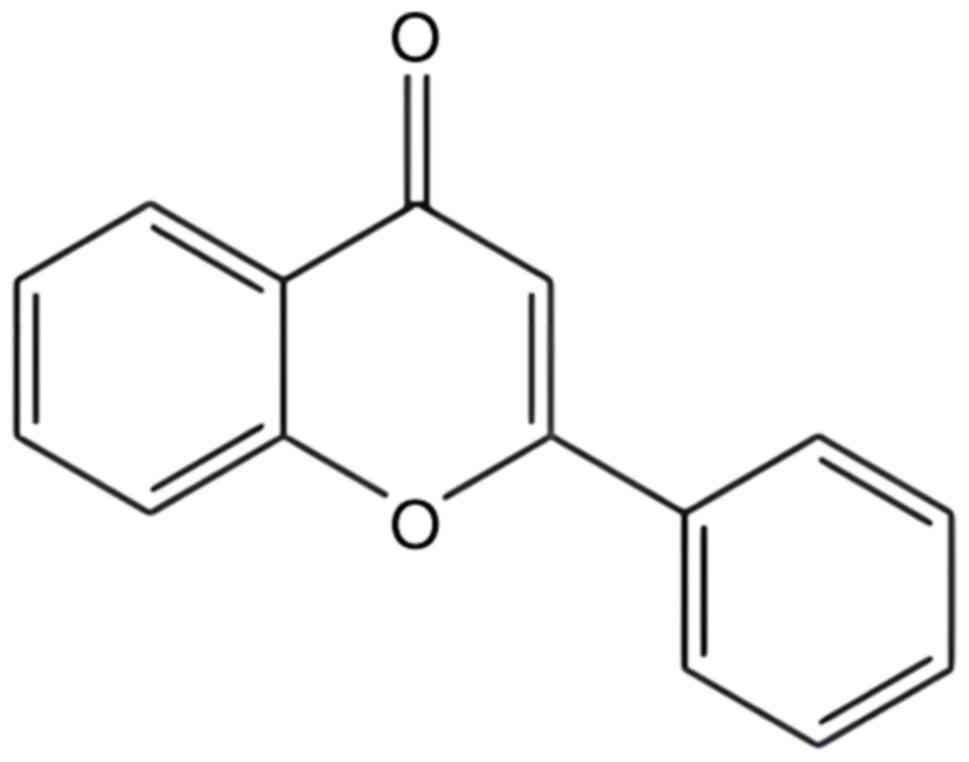 |
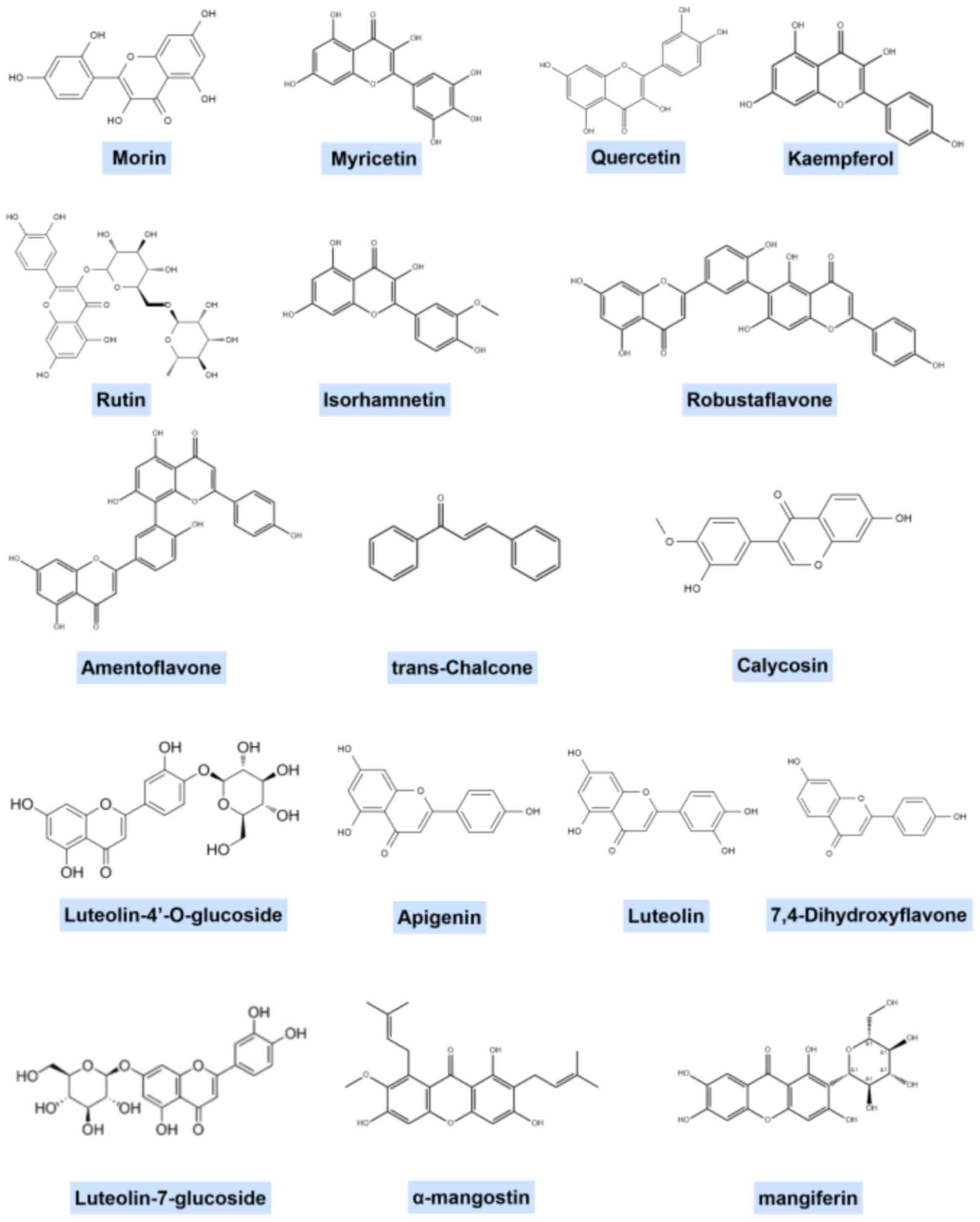 |
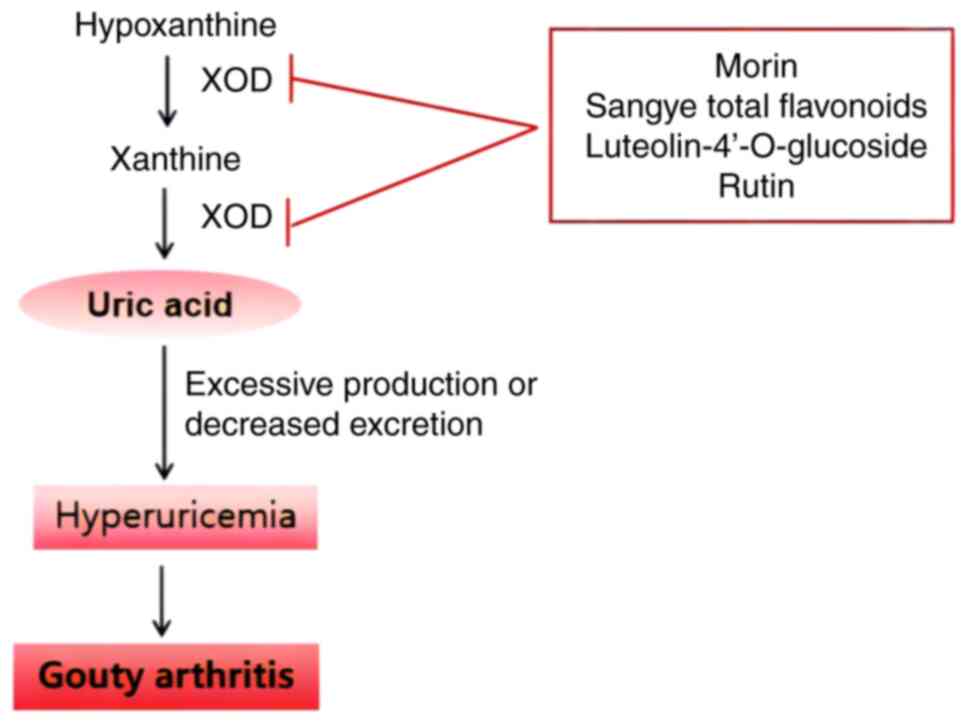 |
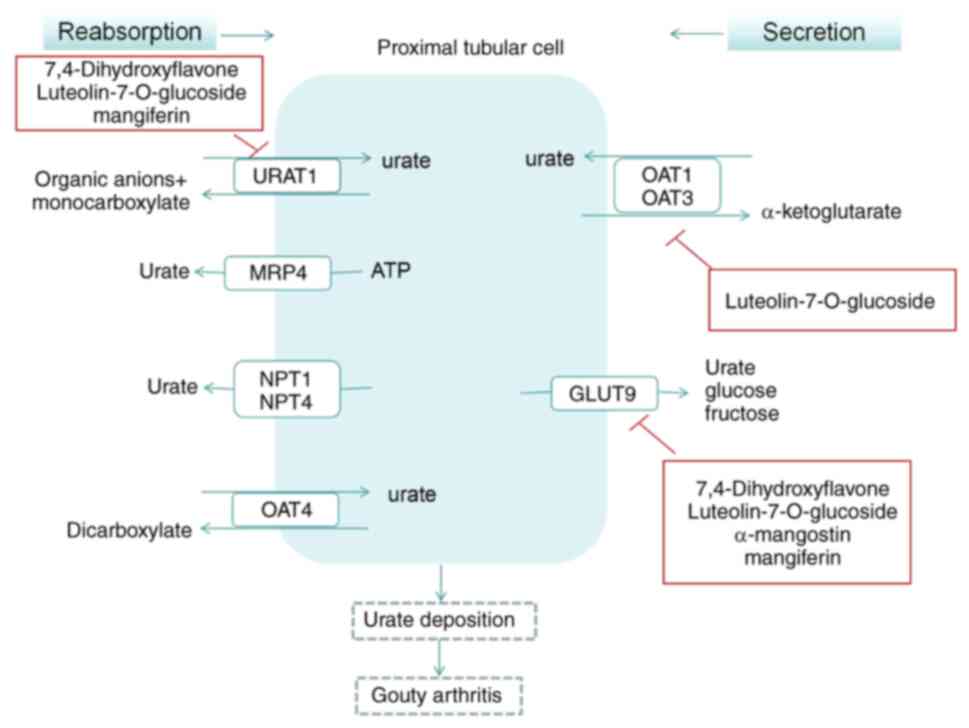 |
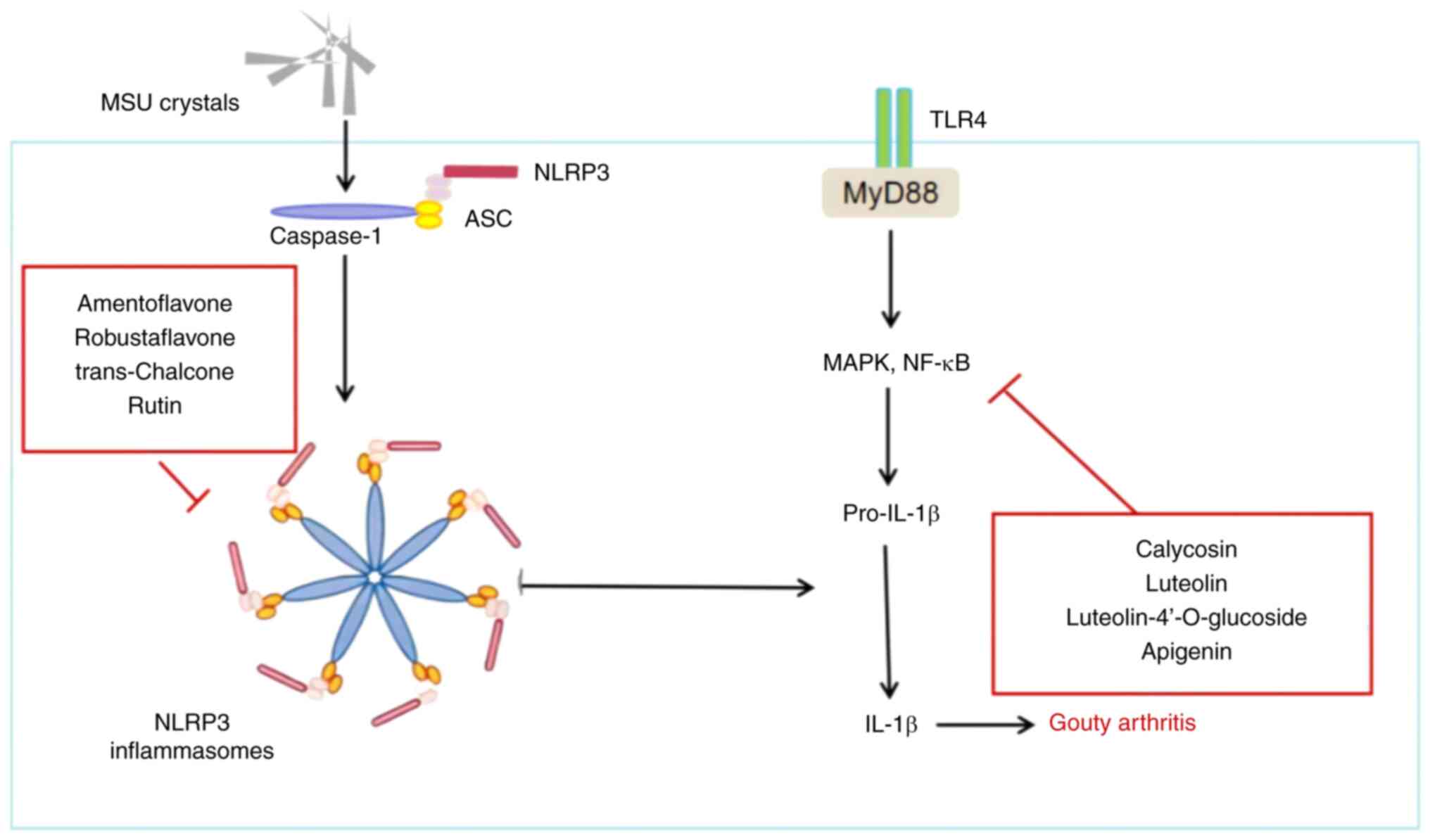 |
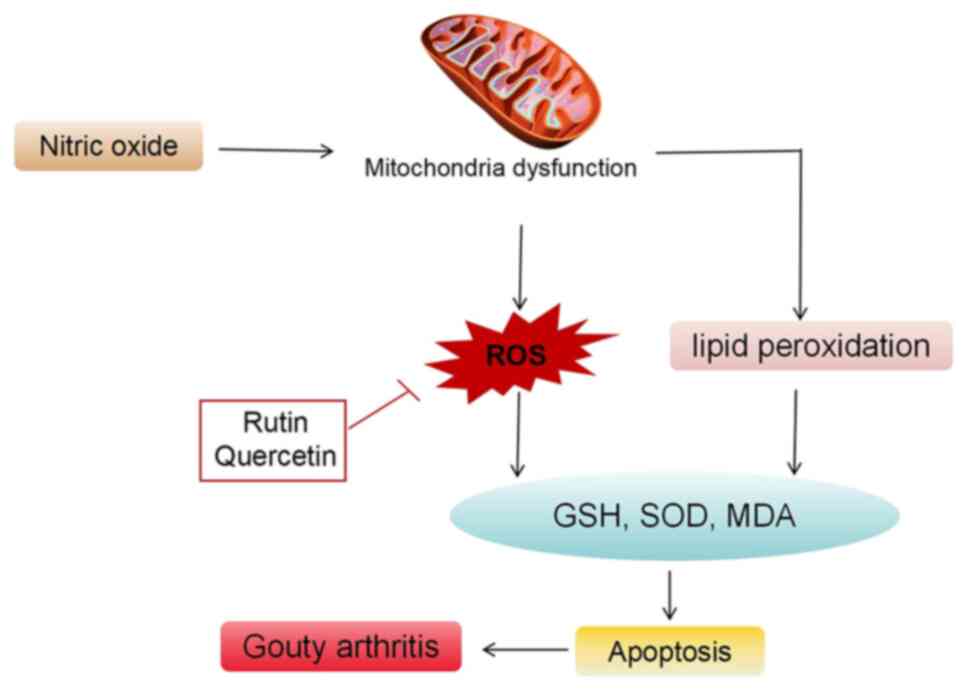 |
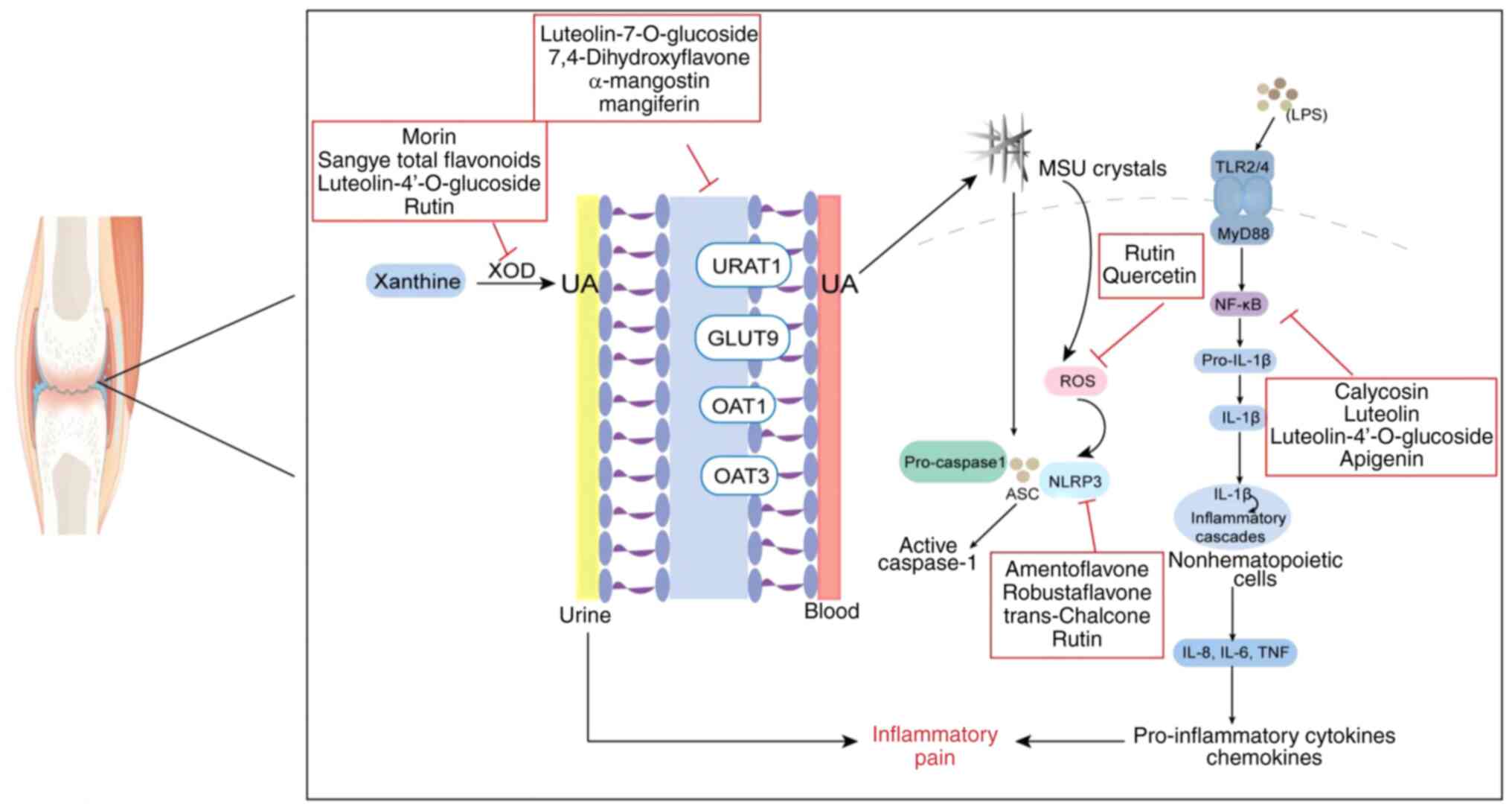 |
|
Cleophas MCP, Crişan TO, Klück V, Hoogerbrugge N, Netea-Maier RT, Dinarello CA, Netea MG and Joosten LAB: Romidepsin suppresses monosodium urate crystal-induced cytokine production through upregulation of suppressor of cytokine signaling 1 expression. Arthritis Res Ther. 21:502019. View Article : Google Scholar : PubMed/NCBI | |
|
Roddy E and Choi HK: Epidemiology of gout. Rheum Dis Clin North Am. 40:155–175. 2014. View Article : Google Scholar : PubMed/NCBI | |
|
Mbuyi N and Hood C: An update on gout diagnosis and management for the primary care provider. Nurse Pract. 45:16–25. 2020. View Article : Google Scholar : PubMed/NCBI | |
|
Ragab G, Elshahaly M and Bardin T. Gout: An old disease in new perspective-a review. J Adv Res. 8:495–511. 2017. View Article : Google Scholar : PubMed/NCBI | |
|
Dewulf JP, Marie S and Nassogne MC: Disorders of purine biosynthesis metabolism. Mol Genet Metab. 136:190–198. 2022. View Article : Google Scholar : PubMed/NCBI | |
|
Liu YR, Wang JQ and Li J: Role of NLRP3 in the pathogenesis and treatment of gout arthritis. Front Immunol. 14:11378222023. View Article : Google Scholar : PubMed/NCBI | |
|
Zhang J, Sun W, Gao F, Lu J, Li K, Xu Y, Li Y, Li C and Chen Y: Changes of serum uric acid level during acute gout flare and related factors. Front Endocrinol (Lausanne). 14:10770592023. View Article : Google Scholar : PubMed/NCBI | |
|
Richette P, Doherty M, Pascual E, Barskova V, Becce F, Castaneda J, Coyfish M, Guillo S, Jansen T, Janssens H, et al: 2018 updated European league against rheumatism evidence-based recommendations for the diagnosis of gout. Ann Rheum Dis. 79:31–38. 2020. View Article : Google Scholar : PubMed/NCBI | |
|
Hu AM and Brown JN: Comparative effect of allopurinol and febuxostat on long-term renal outcomes in patients with hyperuricemia and chronic kidney disease: A systematic review. Clin Rheumatol. 39:3287–3294. 2020. View Article : Google Scholar : PubMed/NCBI | |
|
Rasheed Kayani R, Shamim R, Sultana Munir S, Sultana M, Nazir SUR, Riaz H, Nazir T, Maaz Ali M and Islam A: Medicinal plants and nonsteroidal anti-inflammatory drugs (NSAIDs) in treatment of arthritis: A literature review. Altern Ther Health Med. 28:58–64. 2022.PubMed/NCBI | |
|
Hainer BL, Matheson E and Wilkes RT: Diagnosis, treatment, and prevention of gout. Am Fam Physician. 90:831–836. 2014.PubMed/NCBI | |
|
Lucas G and Droney L: Severe adverse drug reaction to allopurinol. Aust Prescr. 45:130–131. 2022. View Article : Google Scholar : PubMed/NCBI | |
|
Febuxostat, . Updated advice suggests caution in patients with a history of cardiovascular disease. React Wkly 1960. 52023. | |
|
Ali S, Drendel AL, Rosychuk RJ, May SL, McGrath P, Carleton B and Johnson WD: LO049: Ibuprofen or oxycodone? An observational cohort study of post-emergency department discharge management of children's fracture pain. CJEM. 18 (Suppl 1):S472016. View Article : Google Scholar | |
|
Keller SF and Mandell BF: Management and cure of gouty arthritis. Rheum Dis Clin North Am. 48:479–492. 2022. View Article : Google Scholar : PubMed/NCBI | |
|
Atrahimovich D, Avni D and Khatib S: Flavonoids-macromolecules interactions in human diseases with focus on Alzheimer, atherosclerosis and cancer. Antioxidants (Basel). 10:4232021. View Article : Google Scholar : PubMed/NCBI | |
|
Li G, Ding K, Qiao Y and Zhang L, Zheng L, Pan T and Zhang L: Flavonoids regulate inflammation and oxidative stress in cancer. Molecules. 25:56282020. View Article : Google Scholar : PubMed/NCBI | |
|
Chagas MDSS, Behrens MD, Moragas-Tellis CJ, Penedo GXM, Silva AR and Gonçalves-de-Albuquerque CF: Flavonols and flavones as potential anti-inflammatory, antioxidant, and antibacterial compounds. Oxid Med Cell Longev. 2022:99667502022. View Article : Google Scholar : PubMed/NCBI | |
|
Zhang W, Sun C, Zhou S, Zhao W, Wang L, Sheng L, Yi J, Liu T, Yan J, Ma X and Fang B: Recent advances in chemistry and bioactivity of Sargentodoxa cuneata. J Ethnopharmacol. 270:1138402021. View Article : Google Scholar : PubMed/NCBI | |
|
Dhanasekar C and Rasool M: Morin, a dietary bioflavonol suppresses monosodium urate crystal-induced inflammation in an animal model of acute gouty arthritis with reference to NLRP3 inflammasome, hypo-xanthine phospho-ribosyl transferase, and inflammatory mediators. Eur J Pharmacol. 786:116–127. 2016. View Article : Google Scholar : PubMed/NCBI | |
|
Zhang C, Zhao M, Jiang B, Yu J, Hao Q, Liu W, Hu Z, Zhang Y and Song C: Extraction optimization, structural characterization and potential alleviation of hyperuricemia by flavone glycosides from celery seeds. Food Funct. 13:9832–9846. 2022. View Article : Google Scholar : PubMed/NCBI | |
|
Feng S, Wu S, Xie F, Yang CS and Shao P: Natural compounds lower uric acid levels and hyperuricemia: Molecular mechanisms and prospective. Trends Food Sci Tech. 123:87–102. 2022. View Article : Google Scholar | |
|
Altunayar-Unsalan C and Unsalan O: Molecular structure, antioxidant potential, and pharmacokinetic properties of plant flavonoid blumeatin and investigating its inhibition mechanism on xanthine oxidase for hyperuricemia by molecular modeling. ACS Omega. 9:13284–13297. 2024.PubMed/NCBI | |
|
Li J, Li S, Song Q, Ma E and Aimaijiang M: Mechanism of total flavonoids from Ampelopsis grossedentata against gouty arthritis based on multi-level interactive network and in vivo experimental validation. Zhongguo Zhong Yao Za Zhi. 47:4733–4743. 2022.(In Chinese). PubMed/NCBI | |
|
Huang J, Song Y, Zhao P, Feng Y and Liu Y: Experimental Study of Rutin in the Treatment of Acute Gouty Arthritis. Mil Med Joint Logist. 27:533–535+539. 2013. | |
|
Wu H, Wang Y, Huang J, Li Y, Lin Z and Zhang B: Rutin ameliorates gout via reducing XOD activity, inhibiting ROS production and NLRP3 inflammasome activation in quail. Biomed Pharmacother. 158:1141752023. View Article : Google Scholar : PubMed/NCBI | |
|
Huang J, Zhu M, Tao Y, Wang S, Chen J, Sun W and Li S: Therapeutic properties of quercetin on monosodium urate crystal-induced inflammation in rat. J Pharm Pharmacol. 64:1119–1127. 2012. View Article : Google Scholar : PubMed/NCBI | |
|
Qian X and Jiang Y, Luo Y and Jiang Y: The anti-hyperuricemia and anti-inflammatory effects of atractylodes macrocephala in hyperuricemia and gouty arthritis rat models. Comb Chem High Throughput Screen. 26:950–964. 2023. View Article : Google Scholar : PubMed/NCBI | |
|
Sato VH, Chewchinda S, Parichatikanond W and Vongsak B: In vitro and in vivo evidence of hypouricemic and anti-inflammatory activities of Maclura cochinchinensis (Lour.) Corner heartwood extract. J Tradit Complement Med. 10:85–94. 2019. View Article : Google Scholar : PubMed/NCBI | |
|
Nematbakhsh M, Hajhashemi V, Ghannadi A, Talebi A and Nikahd M: Protective effects of the Morus alba L. leaf extracts on cisplatin-induced nephrotoxicity in rat. Res Pharm Sci. 8:71–77. 2013.PubMed/NCBI | |
|
Lin Y, Liu PG, Liang WQ, Hu YJ, Xu P, Zhou J, Pu JB and Zhang HJ: Luteolin-4′-O-glucoside and its aglycone, two major flavones of Gnaphalium affine D. Don, resist hyperuricemia and acute gouty arthritis activity in animal models. Phytomedicine. 41:54–61. 2018. View Article : Google Scholar : PubMed/NCBI | |
|
Wang AH, Jin Y, Wu Y, Cheng XF, Tian QH, Xie Q and Liu W: Research progress on treatment of gout by xanthine oxidase inhibitor in traditional Chinese medicine. Tianjin J Tradit Chin Med. 36:1241–1245. 2019. | |
|
Mudgal R and Singh S: Xanthine oxidoreductase in the pathogenesis of endothelial dysfunction: An update. Curr Hypertens Rev. Feb 2–2024.(Epub ahead of print). View Article : Google Scholar : PubMed/NCBI | |
|
Bardin T and Richette P: Novel uricosurics. Rheumatology (Oxford). 57 (Suppl 1):i42–i46. 2018. View Article : Google Scholar : PubMed/NCBI | |
|
Hu QH, Zhu JX, Ning LI and Miao MX: Effect of jasminoidin on potassium oxonate-induced hyperuricemia in mice and its mechanism. Cent S Pharm. 11:721–725. 2013. | |
|
Cheng Y and Li F: Current status of research on uric acid transporter proteins. J Hubei Univ Med. 36:470–473+486. 2017. | |
|
George RL and Keenan RT: Genetics of hyperuricemia and gout: Implications for the present and future. Curr Rheumatol Rep. 15:3092013. View Article : Google Scholar : PubMed/NCBI | |
|
Anzai N, Ichida K, Jutabha P, Kimura T, Babu E, Jin CJ, Srivastava S, Kitamura K, Hisatome I, Endou H and Sakurai H: Plasma urate level is directly regulated by a voltage-driven urate efflux transporter URATv1 (SLC2A9) in humans. J Biol Chem. 283:26834–26838. 2008. View Article : Google Scholar : PubMed/NCBI | |
|
So A and Thorens B: Uric acid transport and disease. J Clin Invest. 120:1791–1799. 2010. View Article : Google Scholar : PubMed/NCBI | |
|
Johnson RJ, Sanchez-Lozada LG and Nakagawa T: The effect of fructose on renal biology and disease. J Am Soc Nephrol. 21:2036–2039. 2010. View Article : Google Scholar : PubMed/NCBI | |
|
Wikoff WR, Nagle MA, Kouznetsova VL, Tsigelny IF and Nigam SK: Untargeted metabolomics identifies enterobiome metabolites and putative uremic toxins as substrates of organic anion transporter 1 (Oat1). J Proteome Res. 10:2842–2851. 2011. View Article : Google Scholar : PubMed/NCBI | |
|
Bush KT, Wu W, Lun C and Nigam SK: The drug transporter OAT3 (SLC22A8) and endogenous metabolite communication via the gut-liver-kidney axis. J Biol Chem. 292:15789–15803. 2017. View Article : Google Scholar : PubMed/NCBI | |
|
Nigam SK and Bhatnagar V: The systems biology of uric acid transporters: The role of remote sensing and signaling. Curr Opin Nephrol Hypertens. 27:305–313. 2018. View Article : Google Scholar : PubMed/NCBI | |
|
Woodward OM, Köttgen A, Coresh J, Boerwinkle E, Guggino WB and Köttgen M: Identification of a urate transporter, ABCG2, with a common functional polymorphism causing gout. Proc Natl Acad Sci USA. 106:10338–10342. 2009. View Article : Google Scholar : PubMed/NCBI | |
|
Luo S, Cui X and Li X: Uric acid transporter in the kidney. Prog Physiol Sci. 50:231–235. 2019. | |
|
Zhang HJ, Li LN, Zhou J, Yang QQ, Liu PG, Xu P, Liang WQ, Cheng L, Zhang YQ, Pu JB, et al: Effects of Gnaphalium affine D. Don on hyperuricemia and acute gouty arthritis. J Ethnopharmacol. 203:304–311. 2017. View Article : Google Scholar : PubMed/NCBI | |
|
Caporali S, De Stefano A, Calabrese C, Giovannelli A, Pieri M, Savini I, Tesauro M, Bernardini S, Minieri M and Terrinoni A: Anti-inflammatory and active biological properties of the plant-derived bioactive compounds luteolin and luteolin 7-glucoside. Nutrients. 14:11552022. View Article : Google Scholar : PubMed/NCBI | |
|
Jiang Y, Lin Y, Hu YJ, Song XJ, Pan HH and Zhang HJ: Caffeoylquinic acid derivatives rich extract from Gnaphalium pensylvanicum willd. Ameliorates hyperuricemia and acute gouty arthritis in animal model. BMC Complement Altern Med. 17:3202017. View Article : Google Scholar : PubMed/NCBI | |
|
Li P, Ren G, Sun Y, Jiang D and Liu C: Extraction optimization, preliminary identification, and bioactivities in corn silk. Evid Based Complement Alternat Med. 2023:56851742023. View Article : Google Scholar : PubMed/NCBI | |
|
Xv G: Determination on the contents of the flavonoids and the nutritive components in different parts of three corns. J Henan Univ Technol (Natural Science Edition). 82–84. 2001. | |
|
Li P, Song J, Li Q, Zhang Q, Cui H, Guan B, Zhao Y and Song Z: Curative effect analysis of flavone extract from Stigma Maydis on rats of modified acute gouty arthritis model. China Mod Med. 25:8–11. 2018. | |
|
Chi X, Ye H, Ma C, Yue H, Guo J, Lin Z, Sun J, Ye D, Huang X and Lu G: Effect of total flavonoids in corn stigma on uric acid uptake and related gene expression in HK-2 cells. Pharmacol Clini Chin Mater Med. 36:95–100. 2020.(In Chinese). | |
|
Niu Y, Li Q, Tu C, Li N, Gao L, Lin H, Wang Z, Zhou Z and Li L: Hypouricemic actions of the pericarp of mangosteen in vitro and in vivo. J Nat Prod. 86:24–33. 2023. View Article : Google Scholar : PubMed/NCBI | |
|
Hu QH, Zhang X, Wang Y and Kong LD: Mangiferin promotes uric acid excretion and kidney function improvement and modulates related renal transporters in hyperuricemic mice. Yao Xue Xue Bao. 45:1239–1246. 2010.(In Chinese). PubMed/NCBI | |
|
Cobo I, Cheng A, Murillo-Saich J, Coras R, Torres A, Abe Y, Lana AJ, Schlachetzki J, Liu-Bryan R, Terkeltaub R, et al: Monosodium urate crystals regulate a unique JNK-dependent macrophage metabolic and inflammatory response. Cell Rep. 38:1104892022. View Article : Google Scholar : PubMed/NCBI | |
|
Lee YM, Cho SN, Son E, Song CH and Kim DS: Apamin from bee venom suppresses inflammation in a murine model of gouty arthritis. J Ethnopharmacol. 257:1128602020. View Article : Google Scholar : PubMed/NCBI | |
|
Cui R, Li M, Tuerxun G, Li Y and Xie S: Research on the role of toll-like receptor 2 and toll-like receptor 4 and its signal pathway in the pathogenesis of primary gout arthritis. Matrix Sci Pharma. 4:12020. View Article : Google Scholar | |
|
Jeong JH, Hong S, Kwon OC, Ghang B, Hwang I, Kim YG, Lee CK and Yoo B: CD14+ cells with the phenotype of infiltrated monocytes consist of distinct populations characterized by anti-inflammatory as well as pro-inflammatory activity in gouty arthritis. Front Immunol. 8:12602017. View Article : Google Scholar : PubMed/NCBI | |
|
Akahoshi T: Pathological mechanisms of gouty arthritis. Nihon Rinsho. 66:705–710. 2008.(In Japanese). PubMed/NCBI | |
|
Cronstein BN and Sunkureddi P: Mechanistic aspects of inflammation and clinical management of inflammation in acute gouty arthritis. J Clin Rheumatol. 19:19–29. 2013. View Article : Google Scholar : PubMed/NCBI | |
|
Luo H, Tan J, Wei G, Huang L and JL: Advances in the pathogenesis, diagnosis and treatment of gout. Intern Med. 14:47–50. 2019. | |
|
Dai X, Fang X, Xia Y, Li M and Li X, Wang Y, Tao J and Li X: ATP-activated P2X7R promote the attack of acute gouty arthritis in rats through activating NLRP3 inflammasome and inflammatory cytokine production. J Inflamm. 15:1237–1248. 2022. View Article : Google Scholar : PubMed/NCBI | |
|
Xue Y, Li R, Fang P, Ye ZQ, Zhao Y, Zhou Y, Zhang KQ and Li L: NLRP3 inflammasome inhibitor cucurbitacin B suppresses gout arthritis in mice. J Mol Endocrinol. 67:27–40. 2021. View Article : Google Scholar : PubMed/NCBI | |
|
Han J, Shi G, Li W, Xie Y, Li F and Jiang D: Preventive effect of dioscin against monosodium urate-mediated gouty arthritis through inhibiting inflammasome NLRP3 and TLR4/NF-κB signaling pathway activation: An in vivo and in vitro study. J Nat Med. 75:37–47. 2021. View Article : Google Scholar : PubMed/NCBI | |
|
Ou X, Ding T, Yang H, et al: Research progress of signal pathway related to pathogenesis of gouty arthritis. Pharmacol Clin Chin Mater Med. 37:234–240. 2021. | |
|
Kelley N, Jeltema D, Duan Y and He Y: The NLRP3 inflammasome: An overview of mechanisms of activation and regulation. Int J Mol Sci. 20:33282019. View Article : Google Scholar : PubMed/NCBI | |
|
Hulse J and Bhaskar K: Crosstalk between the NLRP3 inflammasome/ASC speck and amyloid protein aggregates drives disease progression in Alzheimer's and Parkinson's disease. Front Mol Neurosci. 15:8051692022. View Article : Google Scholar : PubMed/NCBI | |
|
Wang M, Zhu Y, Zhao H and Zhao HF: Moxibustion intervention improves synovitis by down-regulating NLRP3/Caspase-1/IL-1β signaling of synovial tissue in rats with adjuvant arthritis. Zhen Ci Yan Jiu. 48:1111–1116. 2023.(In English, Chinese). PubMed/NCBI | |
|
Li X and Yang N: Exosome miR-223-3p in the bone marrow-derived mesenchymal stem cells alleviates the inflammation and airway remodeling through NLRP3-induced ASC/Caspase-1/GSDMD signaling pathway. Int Immunopharmacol. 123:1107462023. View Article : Google Scholar : PubMed/NCBI | |
|
Li Z, Guo J and Bi L: Role of the NLRP3 inflammasome in autoimmune diseases. Biomed Pharmacother. 130:1105422020. View Article : Google Scholar : PubMed/NCBI | |
|
Zhang X, Liu Y, Deng G, Huang B, Kai G, Chen K and Li J: A purified biflavonoid extract from selaginella moellendorffii alleviates gout arthritis via NLRP3/ASC/Caspase-1 axis suppression. Front Pharmacol. 12:6762972021. View Article : Google Scholar : PubMed/NCBI | |
|
Rong S, Wan D, Fan Y, Liu S, Sun K, Huo J, Zhang P, Li X, Xie X, Wang F and Sun T: Amentoflavone affects epileptogenesis and exerts neuroprotective effects by inhibiting NLRP3 inflammasome. Front Pharmacol. 10:8562019. View Article : Google Scholar : PubMed/NCBI | |
|
Çevik D, Erdogan S, Serttas R, Kan Y and Kırmızıbekmez H: Cytotoxic and antimigratory activity of retrochalcones from Glycyrrhiza echinata L. on human cancer cells. Chem Biodivers. 20:e2022005892023. View Article : Google Scholar : PubMed/NCBI | |
|
Staurengo-Ferrari L, Ruiz-Miyazawa KW, Pinho-Ribeiro FA, Fattori V, Zaninelli TH, Badaro-Garcia S, Borghi SM, Carvalho TT, Alves-Filho JC, Cunha TM, et al: Trans-chalcone attenuates pain and inflammation in experimental acute gout arthritis in mice. Front Pharmacol. 9:11232018. View Article : Google Scholar : PubMed/NCBI | |
|
Sun X, Li P, Qu X and Liu W: Isovitexin alleviates acute gouty arthritis in rats by inhibiting inflammation via the TLR4/MyD88/NF-κB pathway. Pharm Biol. 59:1326–1333. 2021. View Article : Google Scholar : PubMed/NCBI | |
|
Hu N, Wang C, Dai X, Zhou M, Gong L, Yu L, Peng C and Li Y: Phillygenin inhibits LPS-induced activation and inflammation of LX2 cells by TLR4/MyD88/NF-κB signaling pathway. J Ethnopharmacol. 248:1123612020. View Article : Google Scholar : PubMed/NCBI | |
|
Takeda K and Akira S: Toll-like receptors. Curr Protoc Immunol. 109:14.12.1–14.12.10. 2015. View Article : Google Scholar : PubMed/NCBI | |
|
Zaninelli TH, Fattori V, Saraiva-Santos T, Badaro-Garcia S, Staurengo-Ferrari L, Andrade KC, Artero NA, Ferraz CR, Bertozzi MM, Rasquel-Oliveira F, et al: RvD1 disrupts nociceptor neuron and macrophage activation and neuroimmune communication, reducing pain and inflammation in gouty arthritis in mice. Br J Pharmacol. 179:4500–4515. 2022. View Article : Google Scholar : PubMed/NCBI | |
|
Tian J, Zhou D, Xiang L, Xie B, Wang B, Li Y and Liu X: Calycosin represses AIM2 inflammasome-mediated inflammation and pyroptosis to attenuate monosodium urate-induced gouty arthritis through NF-κB and p62-Keap1 pathways. Drug Dev Res. 83:1654–1672. 2022. View Article : Google Scholar : PubMed/NCBI | |
|
Wang F, Cao J, Li Y, Ren F, Bai J, Dong Q and Guo J: Study of quality markers of antiuric acid formula by grey relational analysis. SN Appl Sci. 3:6612021. View Article : Google Scholar | |
|
Xiong W, Zhang H, Wen L, Wang X, Zhong G, Shi Y, Du X and Zhu J: Effect of Lagotis brachystachys Maxim extract on xanthine oxidase and renal urate transporters in hyperuricemia mice. Chin J New Drugs. 27:1538–1543. 2018. | |
|
Shan J, Ouyang X, Yang H, Wei R, Liu Y, Zhong G, Liu H and Zhu J: Study on the effective parts of Lagotis brachystachys Maxim against acute gouty arthritis in rats. Tradit Chin Drug Res Clin Pharmacol. 32:492–498. 2021.(In Chinese). | |
|
Shi Y, Li X, Wen L, Zeng J, Zhong G, Yao X, Mu Z, Wang X and Zhu J: Anti-acute alcoholic liver injure effects and mechanism of Lagotis brachystachy and lagotis brevituba. Tradit Chin Drug Res Clin Pharmacol. 28:600–605. 2017.(In Chinese). | |
|
Wang L, Zhang H, Shi Y, Li M, Mu Z, Zhong G, Zhu J and Wang H: Chemical constituents from Lagotis brachystachy. Chin Tradit Patent Med. 42:2926–2930. 2020.(In Chinese). | |
|
Nishitani Y, Yamamoto K, Yoshida M, Azuma T, Kanazawa K, Hashimoto T and Mizuno M: Intestinal anti-inflammatory activity of luteolin: role of the aglycone in NF-κB inactivation in macrophages co-cultured with intestinal epithelial cells. Biofactors. 39:522–533. 2013. View Article : Google Scholar : PubMed/NCBI | |
|
Luan RL, Meng XX and Jiang W: Protective effects of apigenin against paraquat-induced acute lung injury in mice. Inflammation. 39:752–758. 2016. View Article : Google Scholar : PubMed/NCBI | |
|
Li Q, Tian Z, Wang M, Kou J, Wang C, Rong X, Li J, Xie X and Pang X: Luteoloside attenuates neuroinflammation in focal cerebral ischemia in rats via regulation of the PPARγ/Nrf2/NF-κB signaling pathway. Int Immunopharmacol. 66:309–316. 2019. View Article : Google Scholar : PubMed/NCBI | |
|
Ouyang X, Li NZ, Guo MX, Zhang MM, Cheng J, Yi LT and Zhu JX: Active flavonoids from Lagotis brachystachya attenuate monosodium urate-induced gouty arthritis via inhibiting TLR4/MyD88/NF-κB pathway and NLRP3 expression. Front Pharmacol. 12:7603312021. View Article : Google Scholar : PubMed/NCBI | |
|
Shen R, Ma L and Zheng Y: Anti-inflammatory effects of luteolin on acute gouty arthritis rats via TLR/MyD88/NF-κB pathway. Zhong Nan Da Xue Xue Bao Yi Xue Ban. 45:115–122. 2020.(In English, Chinese). PubMed/NCBI | |
|
Lee MN, Lee Y, Wu D and Pae M: Luteolin inhibits NLRP3 inflammasome activation via blocking ASC oligomerization. J Nutr Biochem. 92:1086142021. View Article : Google Scholar : PubMed/NCBI | |
|
Wang Z, Chen W, Li Y, Zhang S, Lou H, Lu X and Fan X: Reduning injection and its effective constituent luteoloside protect against sepsis partly via inhibition of HMGB1/TLR4/NF-κB/MAPKs signaling pathways. J Ethnopharmacol. 270:1137832021. View Article : Google Scholar : PubMed/NCBI | |
|
Zhao F, Dang Y, Zhang R, Jing G, Liang W, Xie L and Li Z: Apigenin attenuates acrylonitrile-induced neuro-inflammation in rats: Involved of inactivation of the TLR4/NF-κB signaling pathway. Int Immunopharmacol. 75:1056972019. View Article : Google Scholar : PubMed/NCBI | |
|
Zhu JX, Yang HY, Hu WQ, Cheng J, Liu Y, Yi LT and Cheng HY: Active components from Lagotis brachystachya maintain uric acid homeostasis by inhibiting renal TLR4-NLRP3 signaling in hyperuricemic mice. Inflammopharmacology. 29:1187–1200. 2021. View Article : Google Scholar : PubMed/NCBI | |
|
Newsholme P, Cruzat VF, Keane KN, Carlessi R and de Bittencourt PIH Jr: Molecular mechanisms of ROS production and oxidative stress in diabetes. Biochem J. 473:4527–4550. 2016. View Article : Google Scholar : PubMed/NCBI | |
|
Wójcik P, Gęgotek A, Žarković N and Skrzydlewska E: Oxidative stress and lipid mediators modulate immune cell functions in autoimmune diseases. Int J Mol Sci. 22:7232021. View Article : Google Scholar : PubMed/NCBI | |
|
Cheng JJ, Ma XD, Ai GX, Yu QX, Chen XY, Yan F, Li YC, Xie JH, Su ZR and Xie QF: Palmatine protects against MSU-induced gouty arthritis via regulating the NF-κB/NLRP3 and Nrf2 pathways. Drug Des Devel Ther. 16:2119–2132. 2022. View Article : Google Scholar : PubMed/NCBI | |
|
Zeng D, Yin C, Wei H, Li Y, Yang Y, Nie H, Pan Y, Xu R, Tai Y, Du J, et al: Activation of Nrf2 antioxidant signaling alleviates gout arthritis pain and inflammation. Biomed Pharmacother. 170:1159572024. View Article : Google Scholar : PubMed/NCBI | |
|
Zamudio-Cuevas Y, Hernández-Díaz C, Pineda C, Reginato AM, Cerna-Cortés JF, Ventura-Ríos L and López-Reyes A: Molecular basis of oxidative stress in gouty arthropathy. Clin Rheumatol. 34:1667–1672. 2015. View Article : Google Scholar : PubMed/NCBI | |
|
Wu H, Wang Y, Ren Z, Li Y, Huang J, Lin Z and Zhang B: Overnutrition-induced gout: An immune response to NLRP3 inflammasome dysregulation by XOD activity increased in quail. Front Immunol. 13:10748672022. View Article : Google Scholar : PubMed/NCBI | |
|
Maiuolo J, Oppedisano F, Gratteri S, Muscoli C and Mollace V: Regulation of uric acid metabolism and excretion. Int J Cardiol. 213:8–14. 2016. View Article : Google Scholar : PubMed/NCBI | |
|
Kiltz U, Alten R, Fleck M, Krüger K, Manger B, Müller-Ladner U, Nüsslein H, Reuss-Borst M, Schwarting A, Schulze-Koops H, et al: Evidence-based recommendations for diagnostics and treatment of gouty arthritis in the specialist sector : S2e guidelines of the German society of rheumatology in cooperation with the AWMF. Z Rheumatol. 76:118–124. 2017.(In German). View Article : Google Scholar : PubMed/NCBI | |
|
Zhao S: Clinical efficacy of traditional Chinese medicine soup in the treatment of gout with damp-heat stasis and the pharmacological effects of total flavonoids of the monarch extract Poria cocos (Poria cocos). Capital Food Med. 26:187–188. 2019. | |
|
Engel B, Just J, Bleckwenn M and Weckbecker K: Treatment options for gout. Dtsch Arztebl Int. 114:215–222. 2017.PubMed/NCBI | |
|
Levy RM, Pillai L and Burnett PB: Nutritional benefits of flavocoxid in patients with osteoarthritis: Efficacy and safety. Nutr Diet Suppl. 2:27–38. 2010. View Article : Google Scholar : PubMed/NCBI |









